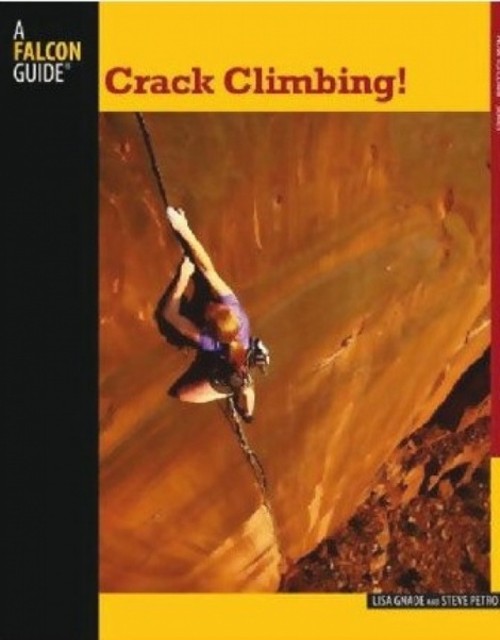Hooked on Crack
Two Utah residents explore and explain the finer points of Crack Climbing!
By Tico AlluleePain is a great teacher. While learning the subtle art of crack climbing through years of twisting various body parts in various fissures is the venerable and accepted way, many climbers have an issue with showing up at work with the bleeding and scabbed hands and ankles that suggest a rendezvous with Fight Club’s Tyler Durden. The addition of Sandy locals Lisa Gnade and Steve Petro’s book Crack Climbing (Falcon 2008) to a newer climber’s library may help alleviate some of the contusions and scar tissue commonly associated with the crackclimbing learning curve.
Petro and Gnade own and run Excalibur, the company that distributes British gear manufacturers Wild Country, DMM and Red Chili in the United States. They’ve been at the leading edge of climbing for decades. Petro looms large in the pantheon of climbing hardmen not just for his linebacker physique, but also his difficult routes, notably Wyoming’s Fremont Canyon roof crack “Fiddler on the Roof,” which went unrepeated for nearly 20 years despite the efforts of many elite climbers. Gnade is an extremely accomplished climber as well, with numerous hard first ascents in the desert to her credit. While both are exceptional all-around climbers, they could be called crack-climbing specialists, which lends them the credibility to produce this book.
The book is roughly divided into three parts: a primer on the hand, foot and body positional techniques commonly employed in crack climbing; a guide to protection gear and its proper use; and a discussion on choosing crags and routes to climb on. Crack-climbing techniques can be quite different than the face-climbing techniques used on sport routes and in the gym. Instead of latching holds, grunting and yelling your way up a face, you use your body parts to fill the emptiness in the stone and progress up the route fluidly (though often grunting as well).
To the untrained eye, crack climbing seems as simple as stuffing your hands and feet into the crack and climbing it like a ladder, but there are subtleties of weight shift, hand and foot positions that often frustrate the beginner. These are explained in the text; an entire chapter is devoted to the strenuous subject of wide cracks, which are generally the bane of newer climbers, although they’ve recently experienced a resurgence in popularity among the climbing cognoscenti. A big part of learning to climb efficiently is being able to visualize what shapes—and in what order—your body will need to assume.
Being able to see this in the book could be a huge help to anyone struggling with a particular set of techniques, be it finger cracks or chimneys.
Because the vast majority of crack routes are protected by gear, the section on gear placements in the book is more than cursory, with detailed photographs of good and bad placements and discussion and analyses of the fall factors and fall lengths ensuing from different gear spacing schemas. The section on choosing a crag and planning a day of climbing gives gentle advice on how to maximize climbing time and enjoyment.
While much of the information in this book could be considered redundant with so many other instructional books available, the presentation of this information—with bright color photographs and numerous illustrations—makes the material especially easy to understand for a crack novice. The book is clearly aimed at the less-experienced climber, although it would make a great resource for an instructor or guide who wishes to be able to teach these techniques more proficiently.
Because the undisputed crack-climbing capitol of the universe, Indian Creek, is located a few hours away from Salt Lake City in southeast Utah, there’s ample opportunity to get out and try the techniques presented. While scrapes and scabs are still the mark of honor for crack climbers, using this book may prevent all but the most worthy of gobies, allowing for longer, more frequent, and more enjoyable days of climbing.
CRACK CLIMBING! Falcon Guides, Lisa Gnade & Steve Petro, 160 pages. Paperback $19.95
Speaking of...
-
Caryn Larrinaga
Previewing the book Donn's Hill with the author before the release.
- Mar 12, 2017
-
Bodega Days: SLC's Forgotten Mall
- Feb 10, 2012
-
Bourdain Bash, Smashburger
When Anthony (Tony) Bourdain—the “bad boy of cuisine”—opened his French brasserie Les Halles in New York City ...
- May 12, 2010
- More »
More by Tico Allulee
-
The Race Card
Plan your year of competitive outdoor endurance, starting this weekend.
- Mar 11, 2009
-
Desert on Ice
Some are near mythical, but ice-climbing routes do exist in southern Utah.
- Feb 19, 2009
- More »



